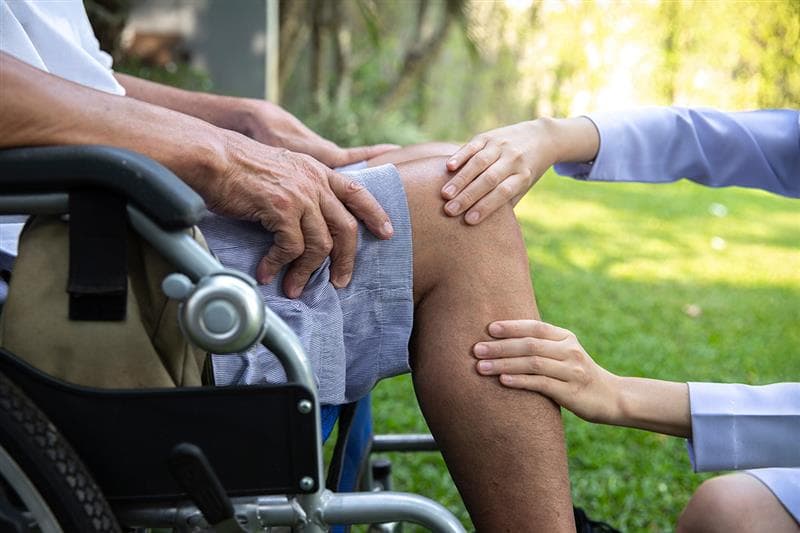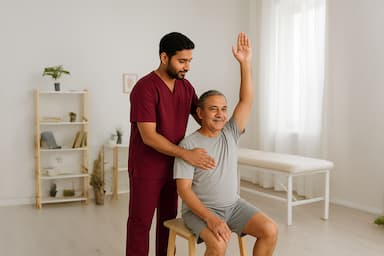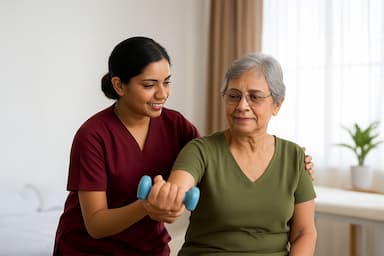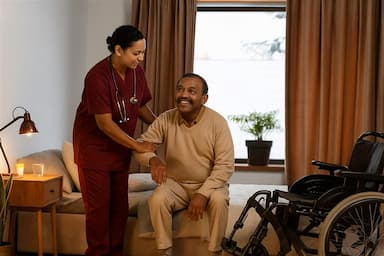
Loading...

Loading...
2025-06-26
Antara
Exercises after knee replacement surgery are vital for seniors' recovery. Most patients reach about 75% recovery by the third month and can return to some sports. Starting physical therapy after knee surgery right away leads to a soaring win in recovery.

The success of the surgery and a patient's functional abilities depend heavily on the range of motion. Quadriceps muscle strength is another key factor that shows how well seniors bounce back. The knee recovery plan unfolds in three phases. These include in-hospital therapy lasting 1 to 3 days, home-based recovery for 2 to 3 weeks, and outpatient rehabilitation extending up to 4 months. Specific physiotherapy exercises can help seniors reduce stiffness, improve circulation, and move more easily during this time.
Moving regularly improves blood flow, which speeds up healing and reduces the risk of complications. A stationary cycle serves as the gold standard for achieving and maintaining a range of motion. Many seniors start surgery with weak quadriceps because knee pain limits their activity. Simple exercises like straight leg raises with three sets of 15 repetitions help rebuild strength. This article outlines the most effective exercises seniors need for a complete and comfortable recovery.
Your recovery experience begins just hours after surgery. Physical therapists visit you in your hospital room to start gentle movements that kickstart the healing process. These exercises might feel uncomfortable at first, but they help decrease post-surgery pain and speed up knee recovery.
The first movements serve three significant purposes: they improve blood circulation, prevent dangerous blood clots, and build strength around your new knee. Here are the simple exercises specialists recommend for the first two weeks:
You can perform these exercises from your bed or while still in the hospital. Your steadfast dedication to the home exercise programme determines your rehabilitation success. Proper form is vital—physiotherapists provide customised instructions for each patient. Your early recovery requires a balance between activity and rest. Swelling reduces when you lie flat with your leg elevated, especially when you have cold packs and muscle-pumping exercises. Additionally, stretching movements gradually increase your knee's range of motion, which is vital for simple functions like walking and sitting. Physical therapists recommend these exercises 3-5 times daily to build strength consistently without overwhelming your recovering joint.
The thoughtful approach to exercise plays a key role after the original phase of recovery. Studies show that patients who participate in early rehabilitation have better functional outcomes.
Move regularly throughout the day. Short sessions of movement work better than long sessions. This simple habit helps healing and prevents stiffness in your new joint. You should get up and move at least once every hour to reduce discomfort and prevent complications, such as blood clots.
Gradually increase intensity and duration. Start with the distance you walked in the hospital and slowly extend both your walking distance and frequency. Walk indoors until your physical therapist gives you the green light for outdoor activity. This careful progression helps build your confidence and reduces the risk of falls.
Follow these senior-specific guidelines:
Prioritise your scheduled therapy. Your physical therapy might continue for 3-4 months based on your progress. Take your prescribed pain medication 30-45 minutes before therapy sessions if pain makes exercises tough.
Balance activity with rest. Movement matters, but pushing too hard can make pain and swelling worse and slow down your recovery. Watch out for increased warmth around the knee or ongoing discomfort - these are signs you are doing too much.
Most seniors can safely return to activities like light weightlifting and low-impact dancing after 3 months post-surgery. By 6 months, many patients can play doubles tennis or try more active forms of dancing with their doctor's guidance.
Care homes create a specialised environment where seniors can recover from knee replacement surgery. These facilities fill a vital gap between leaving the hospital and going back home. They provide well-laid-out support at times when patients need it most. During the recovery process, care homes give patients several major benefits:
Professional Medical Supervision: Skilled experts monitor patients around the clock in care homes and can step in quickly if problems occur. This constant watch makes recovery safer and smoother. The care homes' skilled staff effectively manages pain, which helps patients feel more comfortable and heal faster.
Structured Rehabilitation Programmes: Phcarysiotherapists work directly with residents to help restore movement and function. Each patient gets a consistent, tailored care plan that matches their abilities. The best approach includes functional exercises such as transfers, gait training, and stair climbing. Treatment sessions usually last about 30 minutes.
Personalised Support Systems: Care homes create recovery plans that match each person's needs. Age and social support can affect how someone recovers. Older patients and those without caregivers nearby did better in subacute facilities. Yes, therapy in familiar settings can enhance safety and satisfaction while also helping patients return to their daily routines more quickly.
Many seniors find peace of mind in care homes' structured environment. These facilities serve as valuable stepping stones toward independence after knee replacement surgery.
Walking proves most beneficial after knee replacement. Short indoor walks help rebuild strength and mobility. Your recovery will improve as you gradually increase your walking distance. This helps both your heart health and knee function. Quadriceps sets and straight leg raises are equally important. These exercises strengthen the key muscles that support your new knee.
Early movement is the cornerstone of quick recovery. You should get up and move within hours after surgery. This prevents complications and speeds up healing. Regular exercises 2-3 times daily will build your strength steadily. Your physical therapist's guidance will help you achieve a smooth recovery. Good pain management lets you participate better in rehabilitation activities.
The stationary cycle serves as the gold standard for knee replacement recovery. Most doctors recommend it just two weeks after surgery. It helps improve mobility without putting stress on your joints. Other good options include:
Physical therapy works through different phases:
Most patients need physical therapy for 3-4 months. Some see good results in just 6-8 weeks.
Target exercises that focus on your quadriceps, hamstrings, and hip muscles work best. Wall squats help you build strength for sitting and standing. Step-ups help strengthen your legs for climbing stairs. Straight leg raises work directly on the quadriceps, which often become weak before surgery. Daily stationary cycling for 20-30 minutes strengthens your legs without stressing your joints.

Why Antara Senior Care is Making Post-Op Recovery Easier in ...

Physiotherapy vs. Physical Therapy: What’s the Difference?

Palliative Care for Cancer: Managing Pain & Emotions

Palliative Care: Providing Comfort When It Matters Most

Importance of Home Care Services in Post-Surgery for Elders

Please fill in the form and submit the details to request an appointment.